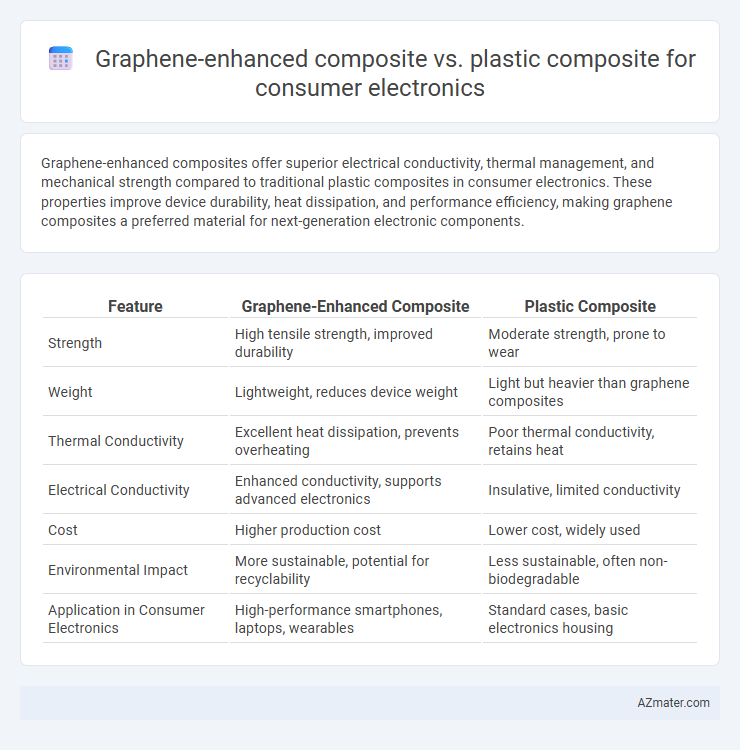Graphene-enhanced composites offer superior electrical conductivity, thermal management, and mechanical strength compared to traditional plastic composites in consumer electronics. These properties improve device durability, heat dissipation, and performance efficiency, making graphene composites a preferred material for next-generation electronic components.
Table of Comparison
| Feature | Graphene-Enhanced Composite | Plastic Composite |
|---|---|---|
| Strength | High tensile strength, improved durability | Moderate strength, prone to wear |
| Weight | Lightweight, reduces device weight | Light but heavier than graphene composites |
| Thermal Conductivity | Excellent heat dissipation, prevents overheating | Poor thermal conductivity, retains heat |
| Electrical Conductivity | Enhanced conductivity, supports advanced electronics | Insulative, limited conductivity |
| Cost | Higher production cost | Lower cost, widely used |
| Environmental Impact | More sustainable, potential for recyclability | Less sustainable, often non-biodegradable |
| Application in Consumer Electronics | High-performance smartphones, laptops, wearables | Standard cases, basic electronics housing |
Introduction to Composite Materials in Consumer Electronics
Graphene-enhanced composites offer superior electrical conductivity, thermal management, and mechanical strength compared to traditional plastic composites used in consumer electronics. These advanced materials enable enhanced device performance, increased durability, and improved heat dissipation, essential for high-performance gadgets like smartphones and wearables. Incorporating graphene into composites addresses key limitations of plastic composites, such as brittleness and thermal instability, making them ideal for the evolving demands of electronic devices.
What are Graphene-Enhanced Composites?
Graphene-enhanced composites are advanced materials that integrate graphene, a single layer of carbon atoms arranged in a hexagonal lattice, into traditional composite matrices to significantly improve mechanical strength, electrical conductivity, and thermal management in consumer electronics. These composites exhibit superior durability and lightweight properties compared to conventional plastic composites, enhancing device performance and longevity. The incorporation of graphene fosters better heat dissipation and electromagnetic interference shielding, crucial for high-performance electronic components.
Overview of Traditional Plastic Composites
Traditional plastic composites in consumer electronics commonly combine polymers such as epoxy, polyethylene, or polypropylene with fillers like glass fibers or carbon fibers to enhance mechanical strength and thermal stability. These composites offer advantages including lightweight properties, design versatility, and cost-effectiveness but often suffer from limited electrical conductivity and moderate thermal dissipation. Despite widespread use, their performance constraints drive the integration of advanced materials like graphene to improve conductivity, strength, and thermal management in modern electronic devices.
Mechanical Strength Comparison
Graphene-enhanced composites exhibit significantly higher mechanical strength compared to traditional plastic composites, with tensile strength improvements often exceeding 30-40%. The incorporation of graphene's atomic-thin layers provides superior stiffness, fracture toughness, and impact resistance, making these composites ideal for durable consumer electronics casings. Plastic composites, while cost-effective, generally lack the enhanced durability and resiliency needed for high-performance electronic devices subject to frequent mechanical stress.
Thermal Conductivity and Heat Dissipation
Graphene-enhanced composites exhibit significantly higher thermal conductivity, ranging from 500 to 2,000 W/mK, compared to traditional plastic composites, which generally have thermal conductivities below 0.5 W/mK. This superior heat dissipation capability ensures efficient thermal management in consumer electronics, reducing the risk of overheating and enhancing device longevity. Enhanced thermal pathways in graphene composites facilitate faster heat transfer away from critical components, improving overall performance and reliability.
Weight and Design Flexibility
Graphene-enhanced composites provide significantly lower weight compared to traditional plastic composites, improving portability and user comfort in consumer electronics. These materials offer superior design flexibility due to their enhanced mechanical strength and electrical conductivity, enabling thinner, more durable, and innovative device form factors. The integration of graphene allows manufacturers to push the boundaries of aesthetic and functional design while maintaining structural integrity.
Electrical Conductivity Differences
Graphene-enhanced composites exhibit significantly higher electrical conductivity compared to traditional plastic composites, enabling superior signal transmission and electromagnetic interference (EMI) shielding in consumer electronics. The incorporation of graphene's two-dimensional carbon lattice facilitates efficient electron mobility, reducing resistance and enhancing overall device performance. This contrasts with standard plastic composites, which typically have poor conductivity and require additional conductive fillers to achieve functional electrical properties.
Environmental Impact and Sustainability
Graphene-enhanced composites for consumer electronics offer superior mechanical strength and thermal conductivity, significantly reducing material usage and extending product lifespan compared to conventional plastic composites. Their enhanced durability leads to lower electronic waste generation, while graphene's higher recyclability potential contributes to improved sustainability profiles. In contrast, plastic composites often rely on fossil-based resources and present challenges in biodegradability and recycling, resulting in higher environmental impact over the product lifecycle.
Cost and Manufacturing Scalability
Graphene-enhanced composites offer superior electrical conductivity and mechanical strength compared to traditional plastic composites, enabling thinner, lighter consumer electronics while maintaining durability. Although graphene materials currently incur higher raw material costs and require specialized processing, advancements in scalable production methods are progressively driving down expenses. Plastic composites benefit from established mass manufacturing infrastructure and lower initial costs, but their limited performance restricts long-term innovation in consumer device miniaturization and heat dissipation.
Future Trends and Applications in Consumer Electronics
Graphene-enhanced composites offer superior electrical conductivity, thermal management, and mechanical strength compared to traditional plastic composites, making them ideal for next-generation consumer electronics such as flexible displays, wearable devices, and high-performance batteries. The integration of graphene improves device durability and reduces heat dissipation issues, enabling slimmer and more lightweight designs in smartphones, laptops, and IoT gadgets. Future trends indicate accelerated adoption of graphene composites driven by advancements in scalable production and cost reduction, expanding applications in smart textiles, foldable screens, and energy-efficient electronic components.

Infographic: Graphene-enhanced composite vs Plastic composite for Consumer electronic
 azmater.com
azmater.com